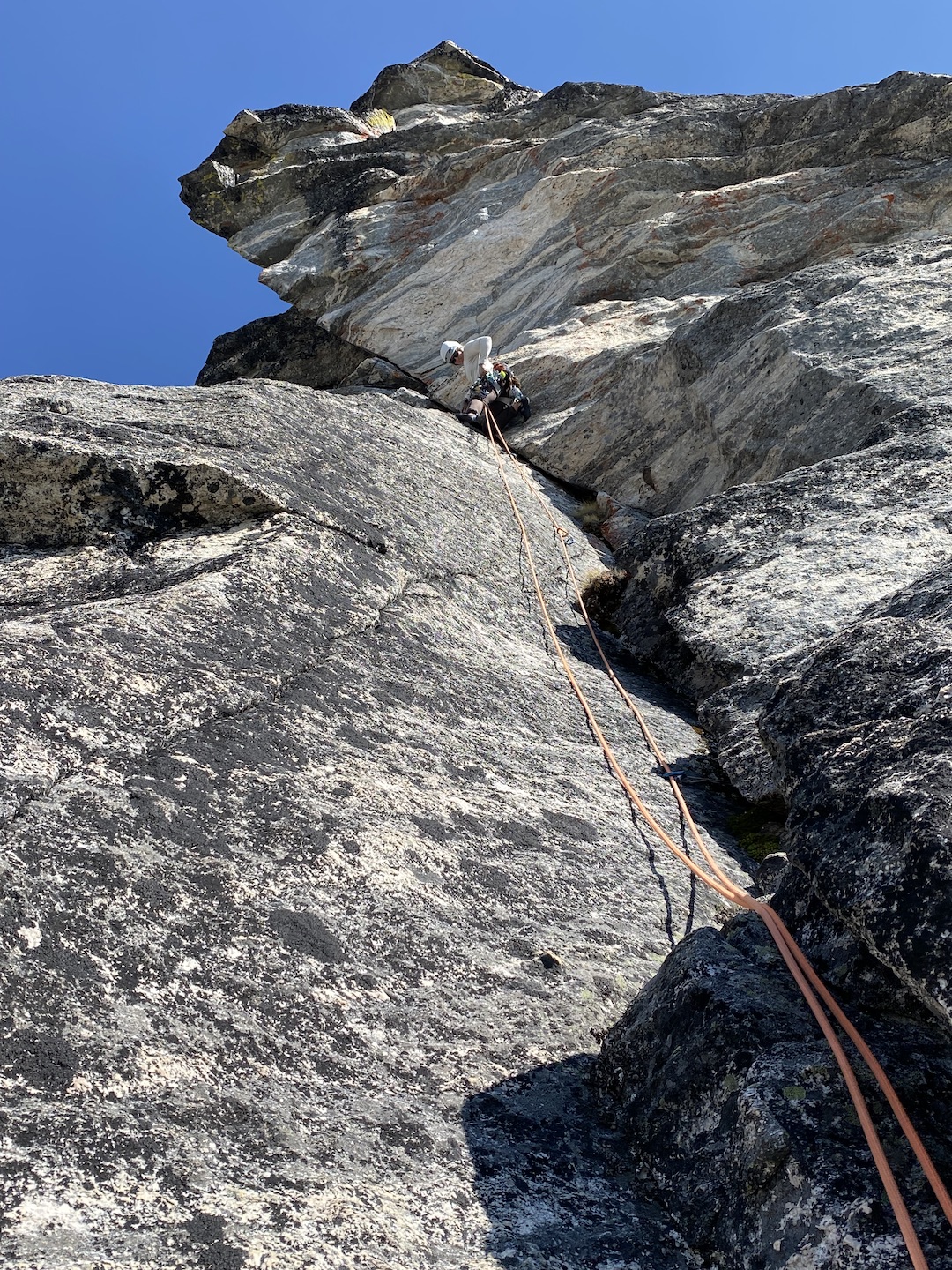Gladsheim Peak, South Face, Crystal Pocket
Canada, British Columbia, Selkirk Mountains, Valhalla Provincial Park
 Sara Lilley and Isobel Phoebus had been to the Valhallas the prior summer, making an ascent of the complete north ridge of Little Dag (Lussier-Senecal, 2015). The south face of Gladsheim Peak (2,830m), the highest summit of the Valhallas, caught their eyes, and later they learned that the last route on this face had been put up 15 years earlier. They reached out to me about some potential new-routing, and, since I was on sabbatical from my job as a wildfire crew leader, I was able to say yes to summer adventures for the first time in eight seasons.
Sara Lilley and Isobel Phoebus had been to the Valhallas the prior summer, making an ascent of the complete north ridge of Little Dag (Lussier-Senecal, 2015). The south face of Gladsheim Peak (2,830m), the highest summit of the Valhallas, caught their eyes, and later they learned that the last route on this face had been put up 15 years earlier. They reached out to me about some potential new-routing, and, since I was on sabbatical from my job as a wildfire crew leader, I was able to say yes to summer adventures for the first time in eight seasons.
In mid-August, we made the approach to Mulvey Basin, and during the first week there we climbed the classic West Ridge (Deane-Oswald-Stewart-Stovel-Williams, 1963) and the South Dihedral (Koedt-Rowat, 1974) on Gladsheim and Etoile Filante (Lussier-Shute, 2011) on Asgard Peak (2,825m). The idea was to immerse ourselves in the history of adventurous climbing in this area, much of which took place in the 1960s and 1970s, when a trail via Mulvey Creek was established and a cabin built by local volunteers, creating a bse camp in the Mulvey Basin. The cabin has burned, and access to the Mulvey Basin has become more of a challenge. Today, the crux for most would be the Gimli-Nisleheim col, requiring crampons and an ice axe to descend the small remnant glacier into the basin.
After studying the south face of Gladsheim for over a week, a line was obvious. The anticipated crux, a hanging, serrated left-facing corner in the center of the face, lit up in the morning sun. We packed a drill, a small bolt kit, pins, offset nuts, and a triple rack of cams.
On the first day, Sara launched up the 55m opening pitch, and Isobel and I followed, enjoying the flowy movement along granitic cracks. We swapped leads to reach the top of pitch three, feeling surprised and elated at how good this line was proving to be. Positioned a rope length below the wild roof system, we were able to get a better eye on the climbing above and noted some wide gear we might need.
Returning the next day, we continued to the summit ridge of Gladsheim, completing Crystal Pocket (435m, 5.10d) clean and free. I was lucky to lead the crux pitch, discovering a magical pocket full of crystals on my way into the overhanging terrain. Good finger locks, wild stemming, and solid protection brought me to the top of the intimidating roof section. I smiled, lichen in my teeth, as I hauled the bags.
Our line bisects the south face of Gladsheim, climbing six pitches of cracks before joining a 5.6 corner system for 100m and then some low-5th-class scrambling. The upper West Ridge leads on to the summit. [The new route is left of the Beckey-Martinson Route (1976) and may briefly follow an earlier line that is not well-documented.] We had the West Ridge descent dialed from our previous mission, efficiently rappelling several short rock steps to reach the descent gully in about three hours.
As we hiked back to camp, we began to doubt this route had never been climbed—it was too good to be true. We held off from celebrating until we could meet guidebook author David Lussier over coffee at Nelson’s famous Oso Negro and realized we had achieved our trip’s purpose: an all-female first ascent in the Valhallas. [This trip was supported by a Jen Higgins Grant for Young Women from the Alpine Club of Canada.]
— Sasha Yasinkski, Canada





